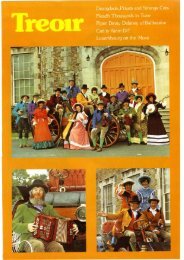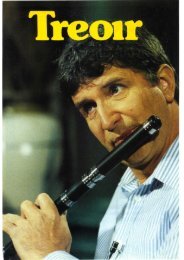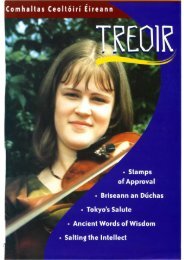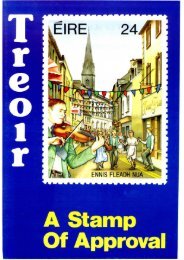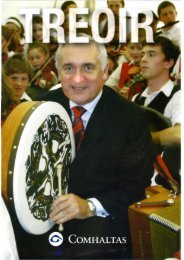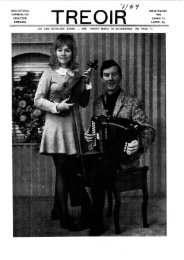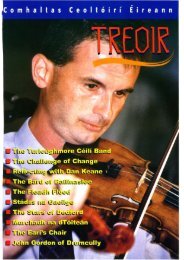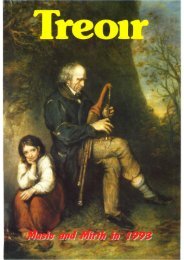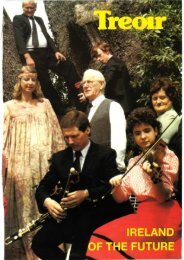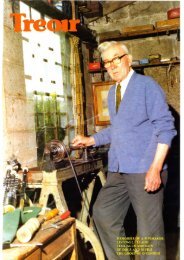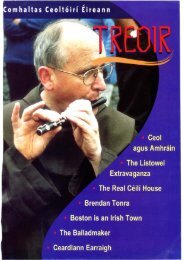Create successful ePaper yourself
Turn your PDF publications into a flip-book with our unique Google optimized e-Paper software.
Co each tune its placeD r Gear6id 6 hAllmhur6in~here was a strange dissonancein the sess ion. The blend hadvanished somewhere in thesecond part of 'The Earl 's Chair'. Coen'sversion sounded odd; an unusual seri esof long notes in the turn. Then themusic gave way to conve rsati on,O'Bri en inquired curi ously. 'Where didyou get th at version of 'The Earl 'sChair', Jack?'The question unlocked a treasury ofdistant memories; the rock in Derryc ragWood, Clanri ckard 's hunt, and originalversions of old Galway tunes that failedto survive the gauntlet of change.'Well! I'll tell you about that tune now,Paddy', sa id Jack, tilting his cap for theya rn , and dismi ssing the noise of traffi crumbling incessa ntly through theconcrete corridors of M anhattan. 'Thattune was composed by a flute player bythe name of Pakie M oloney. He wasfrom Clonco, in the pari sh ofWoodford. He was an uncle of MikeRafferty. ''Mike Rafferty, the flute player w holives in New Jersey?' asked Paddy.'The very man! His un cle Pato, as weused to call him, was out wa lking oneday in Derrycrag Wood and sat downon a big rock to take a rest for himse lf.It was there that the tune came to him.The first name Pato put on it was'Down between the two Derryoobers',after the two town lands of DerryooberWest and Derryoober East, w hich werethere beside him.'And how did it get the name 'The Earl 'sChair' then?' ca me the next question.'Well , in olden times, the Earl ofClanrickard used to come out aroundDerryc rag to gohunting. He owned thehunting ri ghts in thearea. And it seems heused to sit up on this rock to have arest. In fact, the rock was bi g enough forthe hunting party to have lunch on it. Itwas known in the area as 'The Earl 'sChair'. Pato figured that the first namehe had on the tune was a bit long, so herenamed it 'The Earl's Chair' . And that'show the tune got its name. ''And w as it M oloney that put thoselong notes in the turn ?' sa id the boxplayer, getting to the root of thedissonance.'Indeed it was,' replied Coen. 'Th at wasth e original version of the tune I playedth ere. No one is pl aying it that waynow. It was a pity it was ever changed.Those lovely long notes give the tune atotally different character from th atcommon version everyone is play ingtoday. I suppose some 'genius' figuredthe ori ginal version wasn't sophi sticatedenough.' 'I have 'ou now!' sa idO ' Bri en, delighting in the memory andthe folk knowledge of his friend.And so a tune is traced, and a forgottenfragment of musica l geography isunveiled in the midst of a New Yorksession.The perennial art of trac ing is anintegral feature of soc ial discourse inIrish communities. A natural talentborn e by most Irish peopl e; tracing isnurtured by an oral culture in w hichconversation is as much an art ofrememberin g, as a means ofcommunica ti on. Drawing on an archiveof loca l histo ry, fo lklore, and thecollecti ve memori es of community andThe Aughrim Slopes Ceilr Band inKillabeg House in the 1930's. (L to R):Paddy Kelly (fiddle), joe Mills(accordion), Paddy Fahy (fiddle), josieHalloran (piano) and j ack Mulkere{lea der, fiddle!. Ph oto courtesy of EndaMulkere.kin, an evening spent trac ing canunrave l a mosa ic of family genea logies,as well as reca ll a throng of forgottenexiles, politica l conspirators, localpoets, and sporting heroes.It ca n also lead to intense debate abouttraditional music and musicians. The'mighty set dancer', the 'fine traditionalsinger', and the young lad w ho 'washandy w ith the fiddle', all occupy adistinctive place in th e landscape ofmusica l recoll ecti on. Eac h tune has itsown story, each mu sic-maker hi s ownpersonal history, and each sess ion itsown sense of time and place.In this recording, we expl ore the musicand fo lklore of rural communities inClare and Galway. Rather th anemphas ising the moot delineations of'county styles', we focus instead on the'intern al' dialects of villages like FiachRoe and Kilfenora, and the indigenousstyles of Sli abh Aughty, w hi ch stradd lethe lakelands and drumlins of EastClare and Galway. In visiting th esedialects, we sought out an older core oftunes from composers like Paddy Fahy .and Paddy Kelly, and master perform erslike Paddy Cann y, Jack Coen, PeadarO'Loughlin, Paddy Murphy and LucyFa rr. The music of th ese masters hasbeen shaped by an older communal



